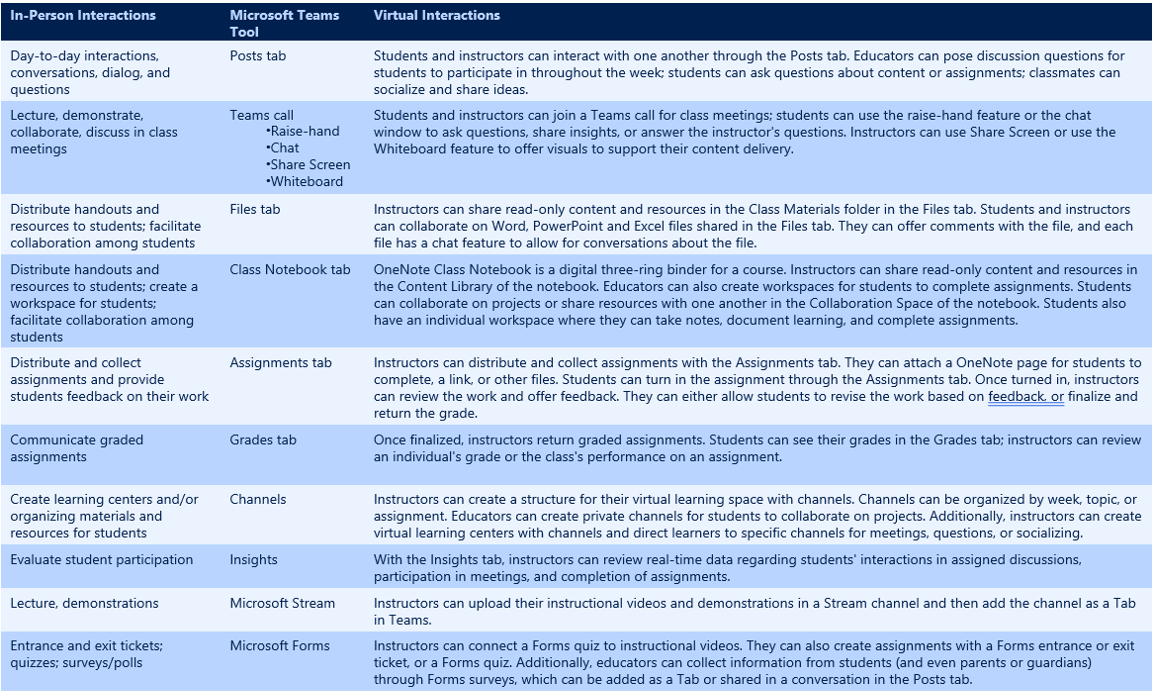Learning environment
Hybrid learning fluidly combines the best of in-school and online learning with digital engagement. Hybrid learning can enhance and accelerate learning by providing student-centered approaches to foster global competencies and meet diverse learners' needs. To create this environment, institutions must create physical and virtual learning spaces that enable dynamic interactions with students who are both in person and remote.
Instructors are well accustomed to in-person instruction. Instructors' learning spaces promote visibility and collaboration. They know how to garner students' attention, gauge understanding, and foster conversations. Instructors have established protocols, procedures, and expectations for students' behavior, class activities, and class assignments. Class management and class workflow are, in short, well-established and comfortable.
When transitioning to a hybrid learning environment, educational institutions can create virtual learning spaces for teachers and students with Microsoft Teams. Teams is the perfect tool for providing continuity and flexibility. As the digital hub for a hybrid classroom, Microsoft Teams allows educators to connect with students in Teams calls, create and collect assignments, share resources, and make collaboration among students easier, whether they are in person or remote. Instructors can also integrate other resources and apps in Teams, making it a central learning space, similar to the physical classroom.
In a hybrid model, educators present their course bi-modally to students who are physically on campus and students who are attending remotely. Instructors therefore need to set up their classroom to optimize instruction for students who are attending virtually via Teams call. Educators need to use a microphone and webcam to ensure virtual students can hear and see the instructor throughout the teaching session. For accessibility, instructors should teach students how to use the closed caption feature in Teams calls. Instructors can also use the Share Screen feature so virtual students can see everything the instructor is demonstrating and discussing.
Educators must establish policies and procedures for their virtual environment. How will students ask questions or get the instructor’s attention? How will instructors take attendance and gauge participation during a synchronous calls? During collaborative work, how will educators break students into groups, get students' attention, and bring everyone back to the main classroom for check-ins or further instruction? Instructors must determine how they can modify their current in-person learning procedures to work in a virtual space.
Instructors should establish a workflow for sharing content and resources, distributing and collecting assignments, offering feedback, and evaluating students' work. Microsoft Teams, OneNote Class Notebooks, and assignments in Teams can streamline everyone's workflow and help students organize class materials, work independently, and prioritize assignments.
Instructors should determine an organizational structure for their virtual learning space. Educators can use channels within Teams to create structure. Channels can be organized in various of ways:
- Weekly channels
- Topic-based channels
- Channels for each activity
- Group-based channels, using private channels.
Instructors can also add specific channels for socializing, meetings, questions, virtual field trips, or learning centers.
Microsoft Teams can be the digital hub for a hybrid learning environment. Core in-person experiences can be translated online with Teams features:

Link to text version of Microsoft Teams the digital hub for the hybrid learning environment